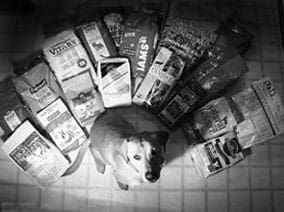Here at WDJ, we talk about dog food all the time, in every single issue. And why not? We feed our dogs every day. Many dogs eat the same food every day of their entire lives (though this is not something we recommend, as we’ll discuss later). Though many veterinarians are just beginning to figure this out, the food that a dog eats has a profound effect on his health. We can quite happily spend an entire day discussing pet food ingredients, say, or regulation of the industry.
So, why on earth does it make us crazy when people call or write to us with the simple and innocent question, “What’s the best food for my dog?” Maybe you had better sit down. This might take a while to explain.
There is no best food for every dog and dog owner
First, you have to understand that every dog is an individual, just like us! While there may be similarities between dogs of similar age, breed, or condition, each individual dog has a unique physiology and metabolism. If your Dalmatian is prone to urinary tract infections, he would probably be better off with a food that has a lower pH. Say you have a Golden Retriever from a family loaded with victims of cancer; you may want to consider fighting his genetic predisposition to developing the disease with an organic food, ideally one with a higher percentage of a quality fat source loaded with Omega 3 and 6 fatty acids.
Every dog’s personal preferences and sensitivities are unique, too. We’ve heard of dogs that won’t touch food that contains beef, and dogs who turn up their noses at the smell of fish oil. We’re intimately familiar with dogs who vomit and suffer from diarrhea if they eat corn, and dogs who can’t stop itching for a month after consuming a meal that contained chicken.
What about the dog’s age, weight, and activity level? Is she a fast young Greyhound whose skinny frame carries no fat whatsoever? She’ll probably need a higher-fat, higher-protein food to keep from disappearing altogether. An older couch potato Cocker Spaniel who never goes out for walks? A low-fat, high fiber food is indicated.
And what about the dog food buyer? Is our nightmare caller on a terribly tight budget? Or is money no object when it comes to his dog? We have taken calls from people who order food on the Internet and have it shipped across the country, and talked with people who say they simply refuse to shop anywhere except Safeway for their dog’s food. We’ve also heard from people who called to say that they have 10 big dogs, and can’t possibly afford high-quality food for all of them; what can you possibly say to someone like that?
So, as you can see, we have our reasons for refusing to tell you what the best dog food is.
But this drives our callers crazy. They just want to know what to feed their dogs! Why can’t we tell them that? So, next, in an effort to trick us into telling them what they want to know, they’ll often ask us, “Well, what do you feed your dog?”
Our selection criteria
By now, you have probably realized that we’re just not going to tell you which food to buy for your dog. Sorry! But we will tell you how you can evaluate a food for quality, and tell you what we look for and look out for in a food. We’ll also give you the names of some foods that we thoroughly approve of, and tell you why we like them. But only you and your dog can determine which is best for you both.
First, however, we have to explain a few things about our selection criteria.
We DON’T conduct lab tests to make sure the Guaranteed Analysis printed on the label accurately reflects the contents; that’s the job of state feed control officials, and way beyond the scope of our resources.
We DON’T inspect manufacturing plants or investigate the manufacturers’ Boards of Directors. It would be interesting and even enjoyable for us to do so, but come on! The costs associated with such a project would be prohibitive, to put it mildly.
We DON’T select foods on the basis of protein or fat content; more is not always better. Many people labor under the misconception that the more protein a food has, the better it is for their dog, so they seek out the highest protein foods on the market. And some manufacturers try to equate high protein with high quality. But some dogs should not eat the highest protein foods. Giant breed puppies, for example, can suffer complications of too-rapid growth on overly high protein diets. Talk to your veterinarian about an appropriate amount of protein and fat in your dog’s diet.
We base our selections on a review of the ingredients and Guaranteed Analysis on the food label. We have acknowledged in previous articles that few states actually test the foods made and/or sold within their borders for labeling violations and inaccuracies. We have also previously informed you that food makers have up to six months to change their labels after changing the ingredients and/or the formulation of a food.
Despite these unfortunate facts, we stand by our decision to make food selections based on the ingredients and Guaranteed Analysis printed on the food labels. After all, the label is all that the average consumer has to go on. And we definitely want to teach you how to analyze a label by yourself; it’s not rocket science.
Also, a quick scan of the ingredients list can tell you a lot about the intentions and philosophy of the company who makes the food. If a maker admits to using artificial preservatives, say, or lots of grain fragments or animal by-products, you can be reasonably sure youre not dealing with a top-of-the-line product. Conversely, if the ingredients list is headed with a quality protein source, and packed with whole, healthy foods, you know you’re in the ballpark.
We don’t examine every food on the market. There are thousands of foods on the market, some nationally distributed, some that are sold only in a single state, and some that are sold very locally. We can’t look at every one.
However, we make every effort to track down products made by companies that make (or claim they make) premium or natural foods. Frequently there is nothing premium or natural about the products; that’s to be expected, because those terms have no legal definition! But it sometimes signals an intent on the part of the food maker to create a truly top-quality, healthy food.
In truth, despite the fact that there are so many food makers scattered across the country, a tiny percentage of them produce WDJ kinds of foods! We think we’re aware of most of the good ones, but there are new players entering the market every day, and some regional companies we’ve never heard of. If you’re aware of a food that meets our selection criteria but is not listed among our top picks, send us some information about it. We frequently review new or newly improved foods throughout the year.
But please, oh please DON’T call and ask us if it would be best for your dog, or if we could tell you over the phone if it’s any good. Hold that label up to our criteria list, below, and YOU can tell US whether it’s good stuff!
So, without any further ado, let’s look at WDJ’s Approved Dry Dog Food List (click here to view).
Also With This Article
Click here to view “Dog Food Manufacturers and the Food Labeling Skepticisms”
Click here to view “Labelling Dog Food Like People Food”
Click here to view “Which is the Best Type of Dog Food?”






